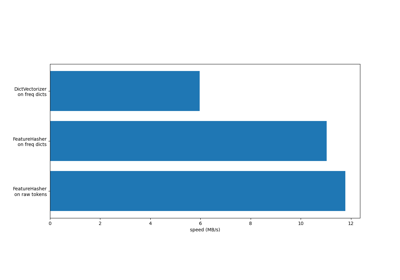Note
Go to the end to download the full example code or to run this example in your browser via JupyterLite or Binder
Column Transformer with Heterogeneous Data Sources¶
Datasets can often contain components that require different feature extraction and processing pipelines. This scenario might occur when:
your dataset consists of heterogeneous data types (e.g. raster images and text captions),
your dataset is stored in a
pandas.DataFrameand different columns require different processing pipelines.
This example demonstrates how to use
ColumnTransformer on a dataset containing
different types of features. The choice of features is not particularly
helpful, but serves to illustrate the technique.
# Author: Matt Terry <matt.terry@gmail.com>
#
# License: BSD 3 clause
import numpy as np
from sklearn.compose import ColumnTransformer
from sklearn.datasets import fetch_20newsgroups
from sklearn.decomposition import PCA
from sklearn.feature_extraction import DictVectorizer
from sklearn.feature_extraction.text import TfidfVectorizer
from sklearn.metrics import classification_report
from sklearn.pipeline import Pipeline
from sklearn.preprocessing import FunctionTransformer
from sklearn.svm import LinearSVC
20 newsgroups dataset¶
We will use the 20 newsgroups dataset, which comprises posts from newsgroups on 20 topics. This dataset is split into train and test subsets based on messages posted before and after a specific date. We will only use posts from 2 categories to speed up running time.
categories = ["sci.med", "sci.space"]
X_train, y_train = fetch_20newsgroups(
random_state=1,
subset="train",
categories=categories,
remove=("footers", "quotes"),
return_X_y=True,
)
X_test, y_test = fetch_20newsgroups(
random_state=1,
subset="test",
categories=categories,
remove=("footers", "quotes"),
return_X_y=True,
)
Each feature comprises meta information about that post, such as the subject, and the body of the news post.
print(X_train[0])
From: mccall@mksol.dseg.ti.com (fred j mccall 575-3539)
Subject: Re: Metric vs English
Article-I.D.: mksol.1993Apr6.131900.8407
Organization: Texas Instruments Inc
Lines: 31
American, perhaps, but nothing military about it. I learned (mostly)
slugs when we talked English units in high school physics and while
the teacher was an ex-Navy fighter jock the book certainly wasn't
produced by the military.
[Poundals were just too flinking small and made the math come out
funny; sort of the same reason proponents of SI give for using that.]
--
"Insisting on perfect safety is for people who don't have the balls to live
in the real world." -- Mary Shafer, NASA Ames Dryden
Creating transformers¶
First, we would like a transformer that extracts the subject and
body of each post. Since this is a stateless transformation (does not
require state information from training data), we can define a function that
performs the data transformation then use
FunctionTransformer to create a scikit-learn
transformer.
def subject_body_extractor(posts):
# construct object dtype array with two columns
# first column = 'subject' and second column = 'body'
features = np.empty(shape=(len(posts), 2), dtype=object)
for i, text in enumerate(posts):
# temporary variable `_` stores '\n\n'
headers, _, body = text.partition("\n\n")
# store body text in second column
features[i, 1] = body
prefix = "Subject:"
sub = ""
# save text after 'Subject:' in first column
for line in headers.split("\n"):
if line.startswith(prefix):
sub = line[len(prefix) :]
break
features[i, 0] = sub
return features
subject_body_transformer = FunctionTransformer(subject_body_extractor)
We will also create a transformer that extracts the length of the text and the number of sentences.
def text_stats(posts):
return [{"length": len(text), "num_sentences": text.count(".")} for text in posts]
text_stats_transformer = FunctionTransformer(text_stats)
Classification pipeline¶
The pipeline below extracts the subject and body from each post using
SubjectBodyExtractor, producing a (n_samples, 2) array. This array is
then used to compute standard bag-of-words features for the subject and body
as well as text length and number of sentences on the body, using
ColumnTransformer. We combine them, with weights, then train a
classifier on the combined set of features.
pipeline = Pipeline(
[
# Extract subject & body
("subjectbody", subject_body_transformer),
# Use ColumnTransformer to combine the subject and body features
(
"union",
ColumnTransformer(
[
# bag-of-words for subject (col 0)
("subject", TfidfVectorizer(min_df=50), 0),
# bag-of-words with decomposition for body (col 1)
(
"body_bow",
Pipeline(
[
("tfidf", TfidfVectorizer()),
("best", PCA(n_components=50, svd_solver="arpack")),
]
),
1,
),
# Pipeline for pulling text stats from post's body
(
"body_stats",
Pipeline(
[
(
"stats",
text_stats_transformer,
), # returns a list of dicts
(
"vect",
DictVectorizer(),
), # list of dicts -> feature matrix
]
),
1,
),
],
# weight above ColumnTransformer features
transformer_weights={
"subject": 0.8,
"body_bow": 0.5,
"body_stats": 1.0,
},
),
),
# Use a SVC classifier on the combined features
("svc", LinearSVC(dual=False)),
],
verbose=True,
)
Finally, we fit our pipeline on the training data and use it to predict
topics for X_test. Performance metrics of our pipeline are then printed.
pipeline.fit(X_train, y_train)
y_pred = pipeline.predict(X_test)
print("Classification report:\n\n{}".format(classification_report(y_test, y_pred)))
[Pipeline] ....... (step 1 of 3) Processing subjectbody, total= 0.0s
[Pipeline] ............. (step 2 of 3) Processing union, total= 0.4s
[Pipeline] ............... (step 3 of 3) Processing svc, total= 0.0s
Classification report:
precision recall f1-score support
0 0.84 0.87 0.86 396
1 0.87 0.84 0.85 394
accuracy 0.86 790
macro avg 0.86 0.86 0.86 790
weighted avg 0.86 0.86 0.86 790
Total running time of the script: (0 minutes 2.491 seconds)
Related examples

Classification of text documents using sparse features

Biclustering documents with the Spectral Co-clustering algorithm


